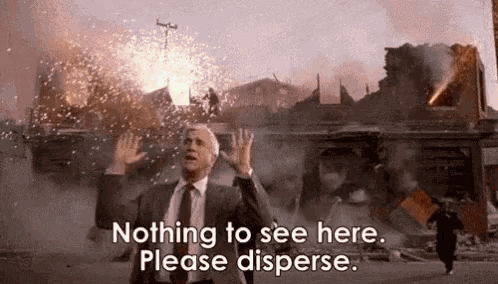- cross-posted to:
- [email protected]
- cross-posted to:
- [email protected]
Reminder that GDP is a bullshit number and so are nearly all made up numbers economists use to justify capitalist wage theft
Portfolios, not bank balances, but otherwise that’s what economy means to capitalists. The economic hardship index is what we all actually care about, but that’s never on the news.
Economist here. There’s obviously no single measure of the state of the economy, and if there were, jobs and wages would clearly be a key component. It’s mostly those “left-wing” journalist that will have you believe that one number, GDP growth, represents the state of the economy.
What “left wing journalists?” I want names. There aren’t any left wing journalists in MSM.
I think that’s why there are quotation marks?
Oof that resonates badly with the community here. I thought that by putting left-wing in quotes, it would be obvious that I was sarcastic, but either people did not read it that way, or something else about my post rubbed people the wrong way.
I actually completely missed them in your post yet noticed them immediately in the reply, maybe some unconcious kneejerk on the the part of people who feel disenfranchised or some freak combination of sentence structure and positioning that causes people to skip over them?
Please provide an example.
Hilarious! This is definitely the right place to post this

video version
This article made a prediction that turned out to be wrong.
In the time since the headline in July 2020, the number of jobs in the U.S. rose back from 139 million to 159 million. (In January 2020, before COVID hit, there were 152 million jobs).
Average weekly earnings went up from $1016 to $1236, a 21.6% increase. That’s come up short on the 23.4% inflation in that time period. But also, this number didn’t drop for COVID, so these wages are higher than in 2019.
People can complain about how the economy isn’t working for regular people, but the last 5 years were actually a pretty good run for wage earners.
These sentences:
Average weekly earnings went up from $1016 to $1236, a 21.6% increase. That’s come up short on the 23.4% inflation in that time period.
answer the implicit question in this sentence:
People can complain about how the economy isn’t working for regular people, but the last 5 years were actually a pretty good run for wage earners.
It wasn’t really a good run. Wages didn’t keep up with inflation. Even though wages are higher, the buying power with those wages is less.
Think it might be grading on a curve. Wages have long lagged inflation. Lagging less than 2 percent over 5 years is bad, but less bad than most 5 year periods in recent history.
Yeah and if wages were already significantly worse than inflation, and continued to stay below it, then peoples buying power decreased even more. It didn’t decrease faster than it was, but it still decreased from what it had been, making them worse off. Looking at 5 year trends foesnt really matter if theres never a true upward swing and its just a consistent downslide. You can say ‘yeah but here in this spot you slowed down slightly’, but the person is still closer to the bottom than they’ve ever been.
Wages didn’t keep up with inflation
Counting back from July 2020, the average weekly earnings per worker came up just short. But the huge addition of workers during the economic recovery would have been expected to dent that further.
Compare the exact same comparison from July 2019 versus April 2025, we have weekly earnings going up from $964 to $1236 (28.2%), while the inflation over that time period was 24.6%. So workers gained across even that metric over this time.
But we’d never say that the economic conditions for regular people improved between July 2019 and July 2020. Those huge job losses during the first few months of the COVID recession were devastating for regular people, even if the average earnings among people who kept their jobs shot upward. It wasn’t because their wages went up, it was that the people who were the lowest earners lost their jobs. As they reentered the workforce, they were taking higher paying jobs than the ones they were previously laid off from, so that overall average stayed stable with the artificially elevated July 2020 number, through improved bargaining power during the great resignation and some recovery of union power, especially in the summer of 2023.
That’s why economic conditions for regular people can’t be measured by a single metric, and all the different stats need to be read together.
Decreasing the rate of loss is good. Not great. Just good. It’s certainly better than average, since average was a much bigger loss.
But it’s semantics. We need to do better regardless.
That doesn’t sound like a good run at all, that sounds like a less terrible run than other terrible runs. Literally wages did not keep up with inflation. The net economic power of workers went down. That’s not a good run.
The net economic power of workers went down.
The aggregate economic power of workers went up, because the actual number of workers went up by 20 million, or 14% of the workforce as of July 2020, and the number of unemployed or involuntarily part time went down over that period of time. There were a lot more wages being distributed per unit population, even if the real wages slightly decreased per worker.
I mis-spoke by saying “net economic power of workers” instead of “economic conditions for the average individual worker”. I have a feeling you understood what I meant anyway: People are hurting more and more.
economic conditions for the average individual worker
My point is that there are at least 20 million people who were not in that category in July 2020 who ended up in that category in April 2025. So the economic conditions for the average person who worked at some point in that 5-year period is going to be a big improvement as the employment rate increases.
So if you try to stabilize the cohort you’re looking at, whether it’s the 140 million who were employed in July 2020 or the 160 million who were employed in April 2025, then tracking the moving median needs to be accounted for.
A comparison between July 2019 and July 2020 makes this obvious. The weekly earnings shot up from $964 to $1016 (5% increase in a year that only saw 1% inflation), but nobody would consider that to be an improvement in conditions. Instead, many of the bottom earning workers just got laid off, making their conditions worse. If that metric isn’t a good standalone indicator of what average people are experiencing, it should be evaluated with the other metrics in mind, too.
The problem with looking at “average wages” is that you’ve got outliers like “Spiders” Elon over there fucking up the numbers.
t wasn’t really a good run. Wages didn’t keep up with inflation. Even though wages are higher, the buying power with those wages is less.
Generally averages, in my opinion, are not a good measure.
Here is the median:
Employed full time: Median usual weekly real earnings: Wage and salary workers: 16 years and over https://fred.stlouisfed.org/series/LES1252881600Q
Edit: Maybe this is even better:
Real Median Personal Income in the United States (MEPAINUSA672N) https://fred.stlouisfed.org/series/MEPAINUSA672N
All of these stats matter, because it shows multiple facets of a complex economic system.
Bottom quartile earnings are here.
Real Median Personal Income
I don’t like using personal income as a metric that represents what’s happening to regular people because it’s noisy data that incorporates retirement income and investment income in the numerator, and includes in the denominator non-earners (including the idle rich, retired people, full time students).
But as part of a broader look at multiple metrics, it should be considered.
Others include the different categories of unemployment (including the underemployed, the weekly hours worked, marginally detached), read with other employment indicators like layoffs and volunary quits, job openings posted, people making unemployment claims for the first time, etc.




